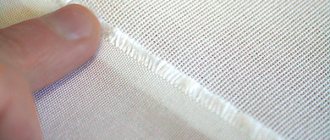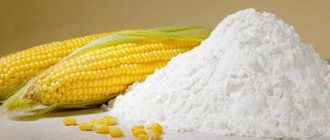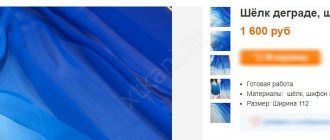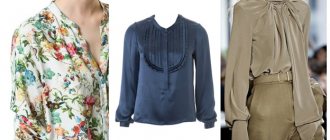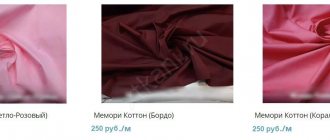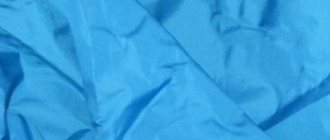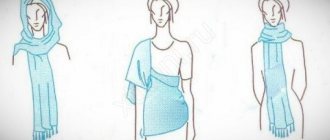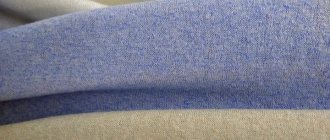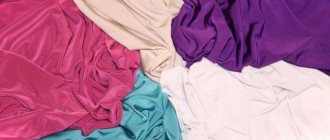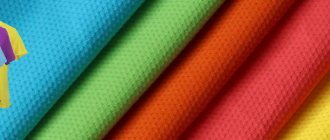Poplin is back in fashion. This dense and durable fabric began to be produced in the 14th century in Avignon; it was used to make clothes for clergymen from the Pope's entourage. The name of the fabric comes from the Italian word papalino, “papal.” It was brought to Russia from Europe only in the 18th century, and was sold as “European calico.”
The manufacturing technology is based on plain weaving, the same as in the manufacture of chintz and calico. With this weaving, a longitudinal thread (weft) intersects vertical threads (warp) one after another; this is the simplest type of weaving. A distinctive feature is the rep effect, formed by small scars, which are obtained due to the use of threads of different thicknesses: a thin thread is used for the warp, a thicker one is used for the weft.
History of origin
Appearing back in the 14th century, poplin was originally a slightly rough but pleasant-to-touch mixed fabric based on silk and wool fibers. The special softness and density made the fabric an element of the attire of the upper classes.
The unusual name of this fabric has a whole history - in medieval Avignon, where the technology for producing this functional and spectacular material originates, the residence of the Pope was located. Vestments for clergy were also sewn there, for which poplin was well suited due to its shape stability and attractive appearance. The fabric we know as “poplin” (from the French popeline or Italian papalino) was simply called “papal”.
- Poplin appeared in Russia much later - only at the beginning of the 18th century under the name “European calico”. At first it was imported exclusively from European countries, but later the manufacturing technology was mastered by Russian weavers. In Soviet times, poplin began to be produced en masse in our country.
What poplin looks like and its weave types
Thin but dense (100-110 g/m2), holding its shape well, suitable for both simple and sophisticated silhouettes, poplin is easy to recognize at first sight. The main feature of the material is the type of weave that forms a small characteristic scar on the surface of the fabric. Up close, you can even see exactly how the threads are connected into the fabric.
The technology for making poplin involves machine-made plain (poplin) weaving of thin warp fibers with thick weft threads, 2 times thicker than for the warp, and the fibers are pressed as closely as possible to each other. The result is a strong and wear-resistant fabric with a soft “reps” surface (dense fibers are “wrapped” in many soft threads).
Varieties of poplin by composition
The most commonly used material in clothing production today is 100% cotton poplin , woven from threads of two different thicknesses. This material is used both for individual tailoring and on a large production scale. An example of quality cotton poplin is Grodesin, which is made from premium quality raw materials in India. Pakistani and Turkish cotton are also excellent for making poplin.
Traditionally, poplin was made from silk fibers; today this technology is used only locally, not on a large scale, due to the high cost of silk raw materials. At the same time, modern technological options are appearing that are not inferior in many characteristics to material with a centuries-old history. Today's analogue of classic silk poplin for tailoring is poplex, a fabric in which a thin and dense cotton base is combined with rare thick synthetic weft threads. Poplex may vary in density and other characteristics, but its cotton content cannot be less than 40%.
To make bed linen in the middle price segment (for the luxury class, only 100% natural ones are chosen, they are denser and softer), another variety of this functional fabric is used - macopoplin or polycotton (polysatin). What kind of material is this? A blend of e-cotton and polyester that, thanks to its synthetic fiber content, holds bright colors well. Also popular are sets of adult and children's bedding made from polypoplin, another mixed variation of the material; according to reviews, products made from it are pleasing with their practicality.
Stretch poplin is a clothing material made of cotton with the addition of lycra. This fabric stretches a little, does not prick, and products made from it fit perfectly to your figure.
There are also types of poplin such as header, extra, elegans.
What is softer, satin or poplin?
You can describe the softness of satin endlessly, remembering how easily it flows and drapes, how softly it sinks the body into silky sheets. Poplin is based on thick threads, so in terms of softness it is noticeably inferior to its competitor.
In addition to the usual double-sided satin, you can also find other types of material on sale: satin jacquard with a convex relief pattern and stripe satin, which can be recognized by alternating matte and glossy stripes. Both materials retain all the advantages of satin, but differ from the classic variation in that they do not have a front and back side. They are both exactly the same.
Varieties of poplin by dyeing method
The color range of modern fabrics, grouped under the “poplin” category, is very diverse. These include plain, printed, and multi-colored fabrics. The following types of poplin differ in the method of dyeing:
- Bleached fabric . A significant part of fabrics with a natural composition undergo the bleaching process - initially such fibers have a natural yellowish, gray tint. Numerous chemicals are used, which are subsequently washed out of the fibers with an alkali solution. As a result, the fabric acquires not only an amazing white shade, but also additional hygroscopicity and a light matte shine.
- With a printed (printed) pattern . Using special printing devices, the design is applied to the fabric using digital printing or airbrushing. Printed fabrics hold small and bright elements of the design well and are safe even for the little ones. Things from them turn out noticeable and unusual.
- Plain-dyed poplin is one of the most common. In this case, an already bleached fabric is dyed; during the process, the fabric is dyed and washed several times, ensuring that the dye is resistant to fading.
- Multicolored material . Such fabric, with a striped or checkered pattern, is obtained if it is woven from already dyed threads.
Pros and cons of poplin
Despite the fact that poplin today has many composition options, the most popular option is still a soft and shape-resistant medium-density cotton material. What differences does it have from other types of cotton, what are its advantages and disadvantages?
Let's start with the positives.
- The softness and comfort of poplin are qualities that make it chosen for sewing summer, body-friendly clothing and bed linen.
- Thanks to its natural composition, the fabric has excellent breathability and hygroscopicity, which means it is characterized by proper thermoregulation.
- Despite its high strength and significant wear resistance, the fabric has a medium density and is suitable for underwear.
- Poplin is a material suitable for those with delicate skin and those who are especially sensitive to the composition of the fabric. In particular, it is well suited for both allergy sufferers and people with atopic skin in remission.
- The fabric, due to the fact that it consists of high-quality cotton, is easy to care for and unpretentious to use. Does not fade, does not shrink, and after ironing it retains its perfect appearance until the next wash.
- Thanks to the use of plain weave technology and different fiber diameters, poplin is textured and wrinkle-resistant.
Poplin has very few disadvantages, and if you encounter them, this will be a sign of choosing a low-quality product. The difference in comparison with a worthy example will be obvious. Poplin woven in violation of technology or from poor raw materials quickly becomes frayed, shrinks, puffs form on it, and it may even lose color. If low-quality dyes are used, there may even be a noticeable chemical smell from the fabric.
All this can be avoided if you buy poplin in trusted places - from manufacturers who have repeatedly proven their approach to work, with quality checks for each batch. Poplin may have different names on its label; the most common are cotton and poplin.
poplin reviews
How to choose the right satin bed linen.
When thinking about buying a new set of bed linen in an online store, you should pay special attention to several of its characteristics.
So, the first and most important thing is the composition. Nowadays, a huge variety of bed linen is produced in Asian countries, where quality is not given the greatest attention. After all, the main thing for the manufacturer is to reduce the cost of production as much as possible, i.e. reduce costs as much as possible. Hiring cheap labor is not always sufficient for this purpose, according to manufacturers. Therefore, most of the bed linen produced in China, Bangladesh and other Asian countries contains artificial fibers, or, simply put, synthetics.
Of course, unscrupulous manufacturers are found not only in China, but we still recommend choosing manufacturers from Turkey or Russia, for example, factories in the city of Ivanovo.
Our opinion is based on our own many years of experience and feedback from our customers. In our store we have collected the most proven and reliable textile companies. All of them have powerful and large-scale production facilities, as well as certificates of compliance with international and Russian quality standards, such as GORST R and ISO 9000.
Of course, Turkish companies are distinguished by their original, interesting and sophisticated designs. Our manufacturers can be distinguished by their good quality and affordable prices. Although there is already a noticeable trend towards improving designs and colors. Especially expensive product lines, such as satin-jacquard bed linen.
So, when choosing bed linen, you should pay attention to the manufacturer and brand recognition. After all, small and unreliable manufacturers can write any information on the label, especially without certificates confirming the accuracy of the stated data.
The composition must be completely natural. It can be 100% cotton, bamboo or eucalyptus fiber.
Noting the trend of recent years, we can note that the most popular bed linen is satin. Satin is a fabric composed of 100% cotton. Unlike calico or poplin, satin bed linen is silkier, thinner and softer. This effect is achieved by special weaving of the thread. The advantages of bedding made from satin are obvious: it is natural, it is pleasant to sleep on, it has a beautiful silky surface, but it is much cheaper, and therefore more accessible to many buyers, than silk. For comparison, the price of bed linen made of natural silk is 20-40 thousand rubles, while bed linen made of satin costs from 2-3 thousand rubles.
By choosing the right manufacturer or store, you can be sure that your satin bedding set will not fade, will not fade, and will last for many years.
We recommend proper care to all our customers in order to extend the life of satin linen.
Like any cotton fabric, it is recommended to wash it at a temperature no higher than 40 degrees, and the first wash of especially bright sets, for example red or black, at no higher than 30 degrees. This does not mean that the dyes are not of high quality. All dyes are natural and durable, it’s just that red and black dyes have their own characteristics when dyeing.
For satin bedding, machine washable.
Because the fabric is thinner and softer, satin is very easy to iron, and practically no wrinkles form on it after drying.
We hope our recommendations will help you make the right choice of bed linen in the online store and make a profitable, useful and pleasant purchase.
Sweet Home online store.
What is made from poplin
Many years have passed since the synthetic revolution swept across the world, and gradually the excitement around artificial fabrics is calming down. Everyone understood that in clothing, as in everything else, a balanced approach and reasonable choice are important. For some purposes, practical and affordable synthetic-based materials are better suited; for other purposes, eco-friendly fabrics are better suited. Poplin has returned to fashion - some models using it have become noticeable trends, others fit well into capsules for a basic wardrobe. What are they sewing from different versions of this fabric today?
Despite the fact that poplin cannot be unambiguously called a dress fabric, current dresses - fluffy, tiered, with puffed sleeves - made from poplin are very impressive. Considering that this fabric is hygienic, in the summer it is difficult to find a more convenient option for walking around the city, photo shoots or gatherings in a cafe. Skirts and jackets, tops with complex designs - cotton material copes with a variety of tasks perfectly.
This fabric will also enrich a man's summer wardrobe - stylish shirts or relaxed holiday shorts are indispensable in the warm season. Thin poplin is considered the ideal shirting material, strong, smooth and suitable for layering, it is stronger than regular cotton.
Poplin will also fit into children's looks - oversized is now popular, and the current silhouettes of girls' dresses are looking more and more voluminous. Plain weave fabric has enough density and lightness to give the desired effect. In addition, stains are easily removed from poplin with regular washing, and children can walk without fear of getting dirty.
Of course, we can’t help but mention bedding, which is made from poplin and is very comfortable, durable, and easy to use. This good fabric is also very popular for home textiles - tablecloths, pillowcases for decorative pillows.
How to sew from poplin?
Working with poplin based on premium cotton is a pleasure! The material does not slip on the table at all during cutting and sewing by hand or on a machine, and is resistant to creases.
- Important ! Before cutting the fabric, decating is necessary.
You can then follow the simple steps to create a new product.
- When cutting and basting parts, connect the layers of fabric with thin pins, this will prevent the fabric from shifting during work.
- We recommend using pencils with water-soluble ink as a marking and marking tool. If you choose chalk, test it on a small piece of material first to avoid any greasy marks.
- Select the appropriate needle and presser foot for your machine. Cotton poplin is quite dense, but sometimes, if selected incorrectly, the needle can leave noticeable holes on the surface of the fabric. Which needle is suitable? We recommend fine, sharp needles that are compatible with your machine.
Which is better?
Poplin and satin are environmentally friendly, natural cotton materials. They are resistant to microorganisms and are not able to provoke an allergic reaction. Both materials absorb moisture well and can be used daily, regardless of the season.
The only thing that can spoil your impression of bedding sets is the dishonesty of the manufacturers. By adding synthetic fibers, they greatly reduce the consumer quality of the products. Therefore, before purchasing, carefully read the label and be sure to study reviews of products from different brands.
Caring for poplin products
Cotton poplin is surprisingly unpretentious. Almost any contaminant can be removed from its surface - in general, the recommended water temperature for washing is 40 degrees, but washing in hotter water, up to 60 degrees, is also allowed. If the stains are still not washed off, light, plain poplin can even be boiled.
Spinning at medium and maximum speed will allow you to get almost dry laundry after washing. If additional drying is required, choose options in a shaded area outdoors or in a well-ventilated area.
The canvas practically does not wrinkle, but if there is a need to refresh the look of poplin clothes, select the “cotton” mode on your iron.
Which is easier to care for?
Caring for poplin depends on the composition of the material. If the manufacturer has added synthetic fibers, the bed can be washed at a maximum of 40 0C. Otherwise, your favorite underwear will shrink. The inclusion of silk fibers suggests hand washing only. And if you trust the washing machine, then set it to the most gentle mode and low speed. You can iron poplin, but the iron temperature should not be at its maximum.
The easiest to care for is poplin made from natural cotton. You can even boil it, and this will not cause the fabric to shrink. Of course, such experiments are only permissible with bleached materials. Drawing requires a more careful attitude.
Pillowcases and duvet covers should be washed inside out. This way you can tidy up the corners of your items, where dust from blankets and pillows always accumulates.
Satin is often called “eternal bed linen.” And this statement is not far from the truth. Satin sets can withstand up to 300 washes and at the same time do not lose either the brightness of their colors or their softness. Linen should be washed at 40–60 0C with soft powder. Bleaching products are prohibited! The products need to be dried by straightening them thoroughly. And then you won’t have to iron your clothes. And if you really want to, then only from the inside out and at the minimum temperature.
Caring for both satin and poplin is not difficult for housewives. In this regard, the materials greatly surpassed calico, ranfors, and chintz.
How to choose poplin?
The modern fabric market is saturated with offers for every taste. With a variety of options, how can you decide and get those materials that will become an excellent basis for your custom-tailored clothing and home textiles?
You recommend fabrics from trusted foreign manufacturers. Poplin made from long-staple cotton from the leading plantations on the planet from our suppliers - a large selection of fabrics of various densities, with different color options from laconic to trendy. We have both basic items and exclusive ones with current designs.
Detailed descriptions and detailed photos indicating the scale of the print will be useful for buyers. They will help you make a choice in favor of materials that exactly suit your needs. The width and cost per linear meter are also indicated in the product cards. There is a convenient sorting by price, you can choose more expensive and cheaper products. Prompt delivery in a convenient way is a nice bonus for those who love quick sewing projects.
Our fabric catalog
Advantages of poplin
Modern poplin is made mainly from long-staple cotton and chemical fibers; silk on a wool base is less commonly used. Poplin, made from 100% cotton, is especially prized. It is brought from India, China, Pakistan, Indonesia and Turkey; the quality of fabric from different manufacturers is practically the same.
Interesting on the topic: cotton fabric composition.
Plain-dyed, bleached, variegated and printed fabrics are produced. Poplin products have the following characteristics:
- soft to the touch, pleasant to the body;
- keep their shape;
- allow air to pass through;
- absorb moisture;
- retain heat;
- do not require ironing after washing.
